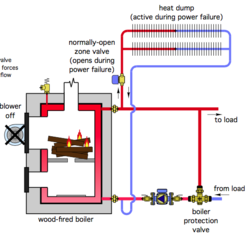taylorfarms
Member
my solution was fairly cheap, 12V school bus circ. pump, battery maintainer, and group 31 batteries, relay to turn the 12V current on when the power drops out, the circ. is in series with my main load circ. to use my house as the dump zone, and it keeps the combine or whatever I rob batteries out of for the winter charged and going.
I had a ton of fin tube I was going to use, but did not want the clutter, and did not see a good way to keep the fin tubes from holding ash/crap that seems to slowly accumulate on every flat surface in the boiler shed. plus I had everything laying around that I needed besides for the pump, and that was cheap enough at the local truck boneyard.
poor people have poor ways I guess
I had a ton of fin tube I was going to use, but did not want the clutter, and did not see a good way to keep the fin tubes from holding ash/crap that seems to slowly accumulate on every flat surface in the boiler shed. plus I had everything laying around that I needed besides for the pump, and that was cheap enough at the local truck boneyard.
poor people have poor ways I guess


